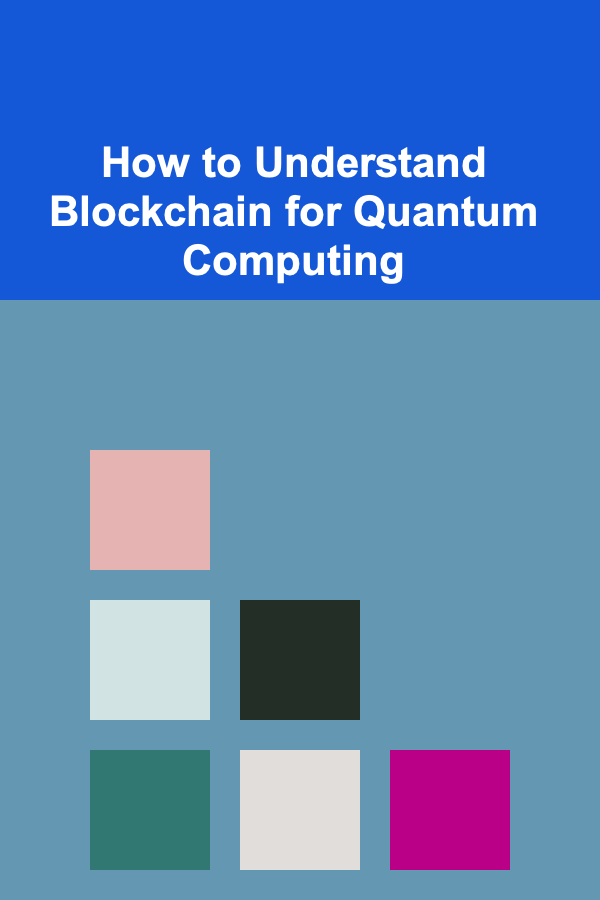
How to Understand Blockchain for Quantum Computing
ebook include PDF & Audio bundle (Micro Guide)
$12.99$6.99
Limited Time Offer! Order within the next:

Blockchain and quantum computing are two revolutionary technologies that are poised to reshape industries worldwide. While each has profound implications for the future of computing and digital systems, their intersection presents a particularly interesting and complex challenge. In this article, we will explore the relationship between blockchain technology and quantum computing, explain how quantum computing could potentially impact blockchain security, and discuss potential solutions for mitigating the risks and leveraging the benefits of both technologies.
Introduction to Blockchain Technology
Blockchain is a decentralized, distributed ledger technology that allows data to be stored across a network of computers in a way that ensures transparency, immutability, and security. The most widely known application of blockchain is Bitcoin, the first cryptocurrency, but blockchain technology has many other applications, including supply chain management, healthcare, finance, and voting systems.
Key Features of Blockchain
- Decentralization: Blockchain operates on a decentralized network of nodes (computers), which means that no single entity has complete control over the system.
- Immutability: Once data is written to the blockchain, it is almost impossible to alter, ensuring that records are permanent and trustworthy.
- Transparency: Blockchain provides transparency by allowing all participants in the network to view the same data, which fosters trust among users.
- Security: Blockchain relies on cryptographic techniques to secure data and transactions. Public-key cryptography, hash functions, and digital signatures are essential for ensuring confidentiality and data integrity.
The decentralized nature and cryptographic security mechanisms of blockchain make it an attractive technology for ensuring the integrity and security of digital transactions. However, as with any emerging technology, blockchain faces challenges, particularly with respect to scalability and security.
Understanding Quantum Computing
Quantum computing is a new paradigm of computation that leverages the principles of quantum mechanics to process information in fundamentally different ways compared to classical computers. While classical computers use bits that represent either 0 or 1, quantum computers use qubits (quantum bits), which can exist in multiple states simultaneously due to the phenomena of superposition and entanglement.
Key Concepts of Quantum Computing
- Qubits: Unlike classical bits, which are either 0 or 1, qubits can represent both 0 and 1 at the same time due to superposition. This allows quantum computers to perform parallel computations.
- Superposition: Superposition is a quantum mechanical property where a qubit can exist in a combination of multiple states. This enables quantum computers to explore many possible solutions at once.
- Entanglement: Entanglement is a phenomenon where the state of one qubit is directly correlated with the state of another, even if they are separated by large distances. This allows quantum computers to perform complex computations that are difficult or impossible for classical computers.
- Quantum Gates and Algorithms: Quantum computers manipulate qubits using quantum gates, which are the quantum analogs of classical logic gates. Quantum algorithms, such as Shor's algorithm (for factoring large numbers) and Grover's algorithm (for searching unsorted databases), can solve certain problems exponentially faster than classical algorithms.
Quantum computing has the potential to revolutionize fields such as cryptography, optimization, and machine learning by solving problems that are currently intractable for classical computers.
The Intersection of Blockchain and Quantum Computing
While blockchain and quantum computing are both groundbreaking technologies, their interaction presents both opportunities and challenges. In particular, quantum computers could potentially undermine the cryptographic foundations of blockchain systems, which rely heavily on the security of classical cryptographic algorithms.
The Threat of Quantum Computing to Blockchain Security
Blockchain technology's security relies on cryptographic algorithms, particularly public-key cryptography, to secure transactions and validate data. In a typical blockchain, each participant has a public-private key pair, and the public key is used to encrypt transactions. The private key is used to sign transactions and decrypt messages. However, quantum computing could break the security provided by these classical cryptographic algorithms through quantum algorithms, most notably Shor's algorithm.
Shor's Algorithm and Public-Key Cryptography
Shor's algorithm is a quantum algorithm that can efficiently factor large numbers, which is a crucial step in breaking the widely used RSA encryption scheme. RSA encryption is based on the mathematical difficulty of factoring large composite numbers, but quantum computers running Shor's algorithm can factor these numbers exponentially faster than classical computers. This means that quantum computers could potentially decrypt RSA-encrypted data, including the cryptographic keys used in blockchain transactions.
The ability to break RSA encryption would undermine the security of blockchain systems that rely on it, making them vulnerable to attacks. However, it's important to note that quantum computers capable of running Shor's algorithm are not yet available, and they may still be years or even decades away. But the threat is real, and it raises important questions about the future security of blockchain systems.
The Impact of Quantum Computing on Blockchain's Consensus Mechanisms
In addition to its effect on encryption, quantum computing could also impact the consensus mechanisms used in blockchain systems, particularly proof-of-work (PoW) and proof-of-stake (PoS). These consensus mechanisms are designed to ensure that all participants in the blockchain network agree on the state of the ledger and prevent double-spending.
- Proof-of-Work: In PoW, miners compete to solve complex mathematical puzzles in order to add new blocks to the blockchain. The security of PoW relies on the computational difficulty of solving these puzzles, which is currently a challenge for classical computers but could be easily solved by quantum computers.
- Proof-of-Stake: In PoS, validators are selected to add blocks to the blockchain based on the amount of cryptocurrency they "stake" as collateral. While PoS is less dependent on computational power, it still relies on the integrity of cryptographic algorithms to prevent malicious actors from creating fraudulent blocks.
Quantum computing could potentially disrupt both of these mechanisms by making it easier to solve cryptographic puzzles or forge blocks, undermining the security and integrity of blockchain networks.
Quantum-Resistant Cryptography for Blockchain
To address the potential threat posed by quantum computing, researchers are developing quantum-resistant cryptography. These are cryptographic algorithms that are designed to be secure against the capabilities of quantum computers. Quantum-resistant cryptography is essential for ensuring the continued security of blockchain systems in a post-quantum world.
Lattice-Based Cryptography
One promising approach to quantum-resistant cryptography is lattice-based cryptography. Lattice-based schemes rely on the mathematical properties of lattices (geometric structures made up of regularly spaced points in space) and are believed to be resistant to quantum attacks. These schemes are being actively researched as alternatives to traditional public-key cryptography algorithms like RSA and ECC (Elliptic Curve Cryptography), which are vulnerable to quantum attacks.
Post-Quantum Cryptographic Standards
The National Institute of Standards and Technology (NIST) has initiated a process to develop and standardize post-quantum cryptographic algorithms. This initiative aims to identify cryptographic algorithms that are secure against both classical and quantum attacks. Once these standards are established, blockchain developers can implement them to future-proof their systems against quantum threats.
Some of the post-quantum cryptographic algorithms being considered include:
- Kyber: A lattice-based public-key encryption scheme.
- NTRU: Another lattice-based encryption scheme that is resistant to quantum attacks.
- FALCON: A digital signature scheme based on lattice problems.
- SIDH: A supersingular isogeny-based key exchange protocol.
By transitioning to these quantum-resistant algorithms, blockchain systems can maintain their security even in the presence of powerful quantum computers.
Hybrid Blockchain Models for Quantum Computing
In addition to adopting quantum-resistant cryptography, another approach is to explore hybrid blockchain models that combine classical and quantum elements. These models could leverage quantum computing's power for certain operations, such as optimizing blockchain consensus or solving complex cryptographic problems, while still maintaining classical security mechanisms.
For example, a hybrid blockchain could use classical encryption for most transactions but rely on quantum computers to perform certain tasks, such as validating complex computations or enhancing the efficiency of blockchain's consensus mechanisms. By combining the strengths of both classical and quantum computing, hybrid models could offer new opportunities for blockchain scalability, speed, and security.
Conclusion
Blockchain and quantum computing are two transformative technologies with the potential to revolutionize many industries. However, their intersection presents both challenges and opportunities. While quantum computers could potentially undermine the cryptographic security of blockchain systems, researchers are actively developing quantum-resistant cryptography and exploring hybrid models to mitigate these risks.
As quantum computing technology continues to advance, blockchain developers must remain vigilant and prepare for a post-quantum world by adopting quantum-resistant cryptographic standards and exploring innovative ways to integrate quantum computing into blockchain systems. By doing so, they can ensure that blockchain remains secure, scalable, and relevant in the age of quantum computing.
Reading More From Our Other Websites
- [Organization Tip 101] How to Achieve Professional Results with a Nail Gun for Trim Work
- [Organization Tip 101] How to Organize Community Resources for Seniors
- [Mindful Eating Tip 101] The Beginner's Toolkit: Essential Tips for Eating with Intention
- [Home Budget Decorating 101] How to Update Your Kitchen on a Budget
- [Whitewater Rafting Tip 101] Paddling Away Stress: The Mind‑Boosting Benefits of White‑water Rafting
- [Polymer Clay Modeling Tip 101] Best Strategies for Designing Custom Polymer Clay Jewelry with Hidden Compartments
- [Home Staging 101] How to Organize Your Closets for Home Staging Success
- [Trail Running Tip 101] Inclusive Trails: How to Adapt Routes and Workouts for Diverse Fitness Levels
- [Personal Investment 101] Building a Passive Income Portfolio with Deep Learning
- [Organization Tip 101] How to Set Up a Virtual Team for Remote Collaboration

How to Build a Checklist for Managing Shipping Delays and Unexpected Issues
Read More
How to Build a Checklist for Reducing Shipping Costs
Read More
How to Make Money Online as a Music Teacher: 10 Actionable Ideas
Read More
How to Organize Your Jewelry Collection with Clever Storage Ideas
Read More
How to Store Rare and Antique Books Safely
Read More
Identifying and Avoiding Processed Foods: A Comprehensive Guide
Read MoreOther Products

How to Build a Checklist for Managing Shipping Delays and Unexpected Issues
Read More
How to Build a Checklist for Reducing Shipping Costs
Read More
How to Make Money Online as a Music Teacher: 10 Actionable Ideas
Read More
How to Organize Your Jewelry Collection with Clever Storage Ideas
Read More
How to Store Rare and Antique Books Safely
Read More